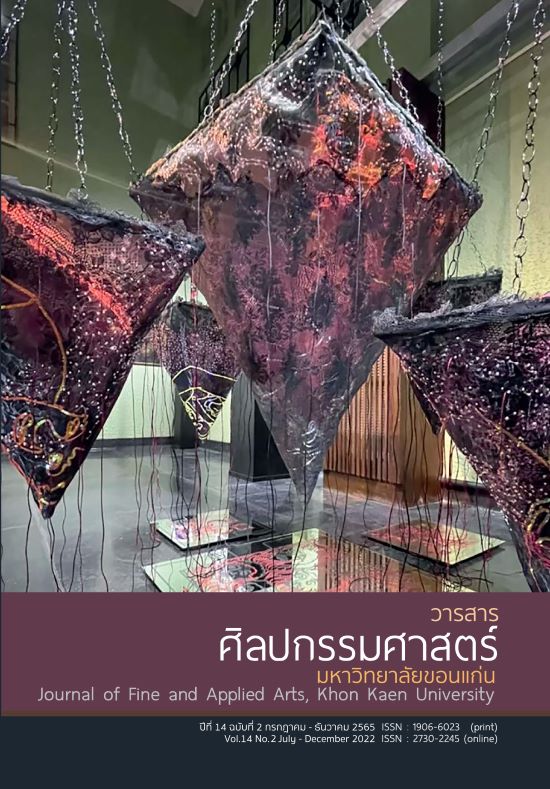การประยุกต์ใช้ท่านาฏศิลป์ไทยในการบริหารกล้ามเนื้อเพื่อเพิ่มความแข็งแรงของกล้ามเนื้อ และความอ่อนตัวในกลุ่มพนักงานออฟฟิศ
Main Article Content
บทคัดย่อ
การวิจัยนี้มีวัตถุประสงค์เพื่อศึกษาผลของการประยุกต์ใช้ท่านาฏศิลป์ไทยในการบริการกล้ามเนื้อเพื่อเพิ่มความแข็งแรงของกล้ามเนื้อ และความอ่อนตัว ในกลุ่มพนักงานออฟฟิศ กลุ่มตัวอย่างในการวิจัยครั้งนี้ เป็นพนักงานออฟฟิศของกรมควบคุมโรค ผ่านเกณฑ์คัดเข้า – คัดออกจำนวน 30 คน เข้าร่วมโปรแกรมท่าทางนาฏศิลป์เพื่อการบริหารกล้ามเนื้อสำหรับพนักงานออฟฟิศ เป็นระยะเวลา 8 สัปดาห์ ๆ ละ 3 ครั้ง (จันทร์, พุธ, ศุกร์) ครั้งละ 60 นาที แบ่งเป็น 3 ช่วง ได้แก่ ช่วงอบอุ่นร่างกาย ช่วงฝึกยืดเหยียดกล้ามเนื้อ และช่วงคลายกล้ามเนื้อ เก็บรวบรวมข้อมูลโดยใช้แบบทดสอบสมรรถภาพทางกายของกรมพลศึกษา ด้านความแข็งแรงของกล้ามเนื้อ และด้านความอ่อน ก่อนการทดลอง และหลังการทดลอง สถิติที่ใช้วิเคราะห์ข้อมูลได้แก่ ค่าเฉลี่ย ส่วนเบี่ยงเบนมาตรฐาน และ One-way repeated measure ANOVA ผลการวิจัยพบว่า 1) ด้านความแข็งแรงของกล้ามเนื้อของแขนข้างขวา เพิ่มขึ้นมากกว่าก่อนเข้าร่วมกิจกรรม มีความแตกต่างอย่างมีนัยสำคัญทางสถิติที่ระดับ 0.05 มีความแตกต่างที่เพิ่มมากขึ้นระหว่างก่อนเข้าร่วมกิจกรรมกับหลังเข้าร่วมกิจกรรมสัปดาห์ที่ 4 และระหว่างก่อนเข้าร่วมกิจกรรมกับหลังเข้าร่วมกิจกรรมสัปดาห์ที่ 8 และ ด้านความแข็งแรงของกล้ามเนื้อของแขนข้างซ้าย ไม่พบความแตกต่างทางสถิติ หลังเข้าร่วมกิจกรรมสัปดาห์ที่ 4, 8 2) ด้านความแข็งแรงของกล้ามเนื้อของขา ไม่พบความแตกต่างทางสถิติ หลังเข้าร่วมกิจกรรมสัปดาห์ที่ 4, 8 3) ด้านความอ่อนตัว ไม่พบความแตกต่างทางสถิติ หลังเข้าร่วมกิจกรรมสัปดาห์ที่ 4, 8
Article Details

อนุญาตภายใต้เงื่อนไข Creative Commons Attribution-NonCommercial-NoDerivatives 4.0 International License.
เนื้อหาและข้อมูลในบทความที่ลงตีพิมพ์ในวารสารคณะศิลปกรรมศาสตร์ มหาวิทยาลัยขอนแก่น ถือเป็นความคิดเห็นและความรับผิดชอบของผู้เขียนบทความโดยตรง ซึ่งกองบรรณาธิการไม่จำเป็นต้องเห็นด้วย หรือร่วมรับผิดชอบใด ๆ
บทความ ข้อมูล เนื้อหา รูปภาพ ฯลฯ ที่ได้รับการตีพิมพ์ในวารสารคณะศิลปกรรมศาสตร์ มหาวิทยาลัยขอนแก่น ถือเป็นลิขสิทธิ์ของวารสารคณะศิลปกรรมศาสตร์ มหาวิทยาลัยขอนแก่น หากบุคคลหรือหน่วยงานใดต้องการนำทั้งหมดหรือส่วนหนึ่งส่วนใดไปเผยแพร่ต่อหรือเพื่อกระทำการใด ๆ จะต้องได้รับอนุญาตเป็นลายลักอักษรจากวารสารคณะศิลปกรรมศาสตร์ มหาวิทยาลัยขอนแก่น ก่อนเท่านั้น
เอกสารอ้างอิง
กองกิจกรรมทางกายเพื่อสุขภาพ กรมอนามัย. (2562). รอบรู้สุขภาพวัยทำงาน. กรุงเทพฯ : คิวคัมเบอร์ (ประเทศไทย).
กัญญาวีร์ เปี้ยนสีทอง. (2560). การบริหารกล้ามเนื้อในผู้สูงอายุ โดยใช้กิจกรรมนาฏศิลป์บำบัด สำหรับชุมชนไทยพวน จังหวัดนครนายก. ปริญญานิพนธ์ปริญญาการศึกษามหาบัณฑิต สาขาศิลปศึกษา บัณฑิตวิทยาลัย มหาวิทยาลัยศรีนครินทรวิโรฒ.
ณัฐธร ขุนทอง. (2554). ผลการฝึกรำมโนราห์ที่มีต่อความแข็งแรงและการทรงตัวของผู้สูงอายุ. ปริญญานิพนธ์ปริญญาการศึกษามหาบัณฑิต สาขาพลศึกษา บัณฑิตวิทยาลัย มหาวิทยาลัยศรีนครินทรวิโรฒ.
นภษร ศรีวิลาศ. (2560). อ่อนช้อยนางรำคาร์ดิโอ้แบบไทยๆ ที่อ่อนช้อยและแข็งแกร่งไปพร้อมกัน. ค้นเมื่อ 25 กุมภาพันธ์ 2562, จาก https://readthecloud.co/entrepreneur-12/
นิภาพร เหล่าชา. (2553). ผลของการออกกำลังกายท่าฤาษีดัดตนที่มีต่อความแข็งแรงของกล้ามเนื้อและความอ่อนตัวในผู้หญิงวัยทำงาน. วิทยานิพนธ์ปริญญาวิทยาศาสตรมหาบัณฑิต สาขาวิทยาศาสตร์การกีฬา บัณฑิตวิทยาลัย จุฬาลงกรณ์มหาวิทยาลัย.
นิวัฒน์ บุญสม. (2560). การพัฒนาความอ่อนตัวด้วยการยืดเหยียดกล้ามเนื้อ. วารสารอิเล็กทรอนิกส์ Veridian มหาวิทยาลัยศิลปากร (มนุษยศาสตร์สังคมศาสตร์และศิลปะ), 10(2), 2173-2184.
พจนานุกรมฉบับราชบัณฑิตยสถาน. (2546). ดนตรี. กรุงเทพฯ : นานมีบุ๊คส์พับลิเคชั่นส์.
ไพศาล จันทรพิทักษ์. (2557). การสร้างความแข็งแรงให้กล้ามเนื้อ. ค้นเมื่อ 20 มิถุนายน 2562, จาก http://www.bangkokhealth.com/health/article
โรงพยาบาลกรุงสยามเซนต์คาร์ลอส. (2562). ออฟฟิศซินโดรม. ค้นเมื่อ 3 มิถุนายน 2562, จาก http://www.stcarlos.com
วิศาล คันธารัตนกุล. (ม.ป.ป.). การออกกำลังกายในวัยทำงาน. กรุงเทพฯ : กองออกกำลังกายเพื่อสุขภาพ กรมอนามัย.
สถาบันบัณฑิตพัฒนศิลป์. (2558). นาฏศิลป์ไทย รำ ระบำ ละคร โขน. กรุงเทพฯ : สถาบันบัณฑิตพัฒนศิลป์ กระทรวงวัฒนธรรม.
สำนักการแพทย์ กรุงเทพมหานคร. (ม.ป.ป.). โรคออฟฟิศซินโดรม. ค้นเมื่อ 25 สิงหาคม 2562, จาก http://www.msdbangkok.go.th/healthconner_Office%20syndrome.htm
สำนักงานกองทุนสนับสนุนการสร้างเสริมสุขภาพ. (2558). สัญญาณเสี่ยงโรคออฟฟิศซินโดรม. ค้นเมื่อ 29 สิงหาคม 2562, จาก https://www.thaihealth.or.th
สำนักงานสถิติแห่งชาติ. (2561). การสำรวจการมีการใช้เทคโนโลยีสารสนเทศและการสื่อสารในครัวเรือน พ.ศ. 2561 (ไตรมาส 1). กรุงเทพฯ : สำนักงานสถิติแห่งชาติ.
สำนักวิทยาศาสตร์การกีฬา กรมพลศึกษา. (2556). การยืดเหยียดกล้ามเนื้อด้วยหลักวิทยาศาสตร์การกีฬาในนักกีฬา. ค้นเมื่อ 3 กรกฎาคม 2562, จาก. https://www.dpe.go.th/ dwl-preview-401891791937
สำนักวิทยาศาสตร์การกีฬา กรมพลศึกษา. (2558). แบบทดสอบและเกณฑ์มาตรฐานสมรรถภาพทางกายของประชาชน อายุ 19–59 ปี. กรุงเทพฯ : กรมพลศึกษา.
อัจจิมา สวัสดิชีวิน. (2548). นาฏยบำบัด. กรุงเทพฯ : มหาวิทยาลัยราชภัฏธนบุรี.

